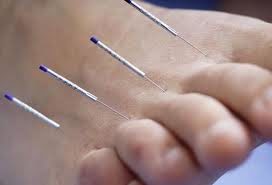
Acupuncture Needles Inserted In A Foot
Acupuncture is an alternative treatment for diabetic neuropathy that many people are not aware of. It is not a course of action that many Western medical doctors would recommend, however, there are nonetheless many people who believe they get great benefits from the procedure.
So is there any evidence that acupuncture really does help to alleviate the painful symptoms of peripheral neuropathy? Scientifically, little is understood about the mechanisms that acupuncture uses and much of our knowledge about procedure currently is only anecdotal.
It is based on an ancient Chinese theories which have been difficult to verify in the laboratory. One of the reasons for this is because acupuncture is so invasive in its nature that it is difficult to develop they suitable placebo for use in clinical trials.
Despite Western medicines scant scientific knowledge of acupuncture, it cannot be denied that there is significant anecdotal evidence that it does help to alleviate many forms of pain in many patients. It is especially helpful for sufferers of HIV, diabetics, and those suffering from diabetic and peripheral neuropathy.
How does acupuncture alleviate diabetic neuropathy symptoms?
Acupuncture is thought to increase blood flow and thus promote tactile sensation and the healing and regeneration of nerves that have been affected by the long-term uncontrolled glucose levels associated with type II diabetes.
In addition, it stimulates nerve endings that have been damaged and desensitized by diabetes. This is thought to massage the nerve endings and stimulate increased feeling and sensation in the feet and hands.
How is acupuncture performed for diabetic neuropathy?
Acupuncture is both an art and science, and much of the procedure will be determined by the specific practitioner that you choose. Usually, sessions are more frequent at the beginning, and once healing begins and an improvement is noticed by the patient, the visits to the acupuncturist will become less frequent.
Usually for the first few weeks you will visit the practitioner 2 to 3 times a week and after that about one time per week. Most people notice an improvement in their symptoms after 1 to 2 sessions, but it can vary and some people (estimated at about 20%) report that they do not receive any relief in their symptoms from their acupuncture treatments.
The acupuncturist will place the needles in the areas where your symptoms are occurring, usually in the hands and feet. The needles are hair thin and little to no pain is felt during insertion as they are much thinner than the usual intravenous needles and the pain is not comparable.
Additionally, the practitioner may insert needles in the nerves along the pathway to the central nervous system and spine. This depends on the severity of your symptoms and the preferences of your specific acupuncturist.
What percentage of people report that acupuncture is helpful with their neuropathy symptoms?
Studies report that in general about two thirds of people report that the tingling and burning pain that they experience with diabetic neuropathy is alleviated through treatments. This number is statistically significant and indicates that there is definitely some efficacy to the procedure despite its lack of endorsement from the Western medical practitioners.
It is most recommended for people who have not responded sufficiently to standard medicines and treatments for the disease. Unfortunately, some sufferers of diabetic neuropathy find little to no relief and thus turn to alternative forms of treatments such as acupuncture.
Most patients report that their symptoms are not completely healed through acupuncture, but only alleviated somewhat. So it is not a magic bullet, but definitely has its place as an option for treatment of peripheral neuropathy.
If you feel adventurous or dare we say desperate, we recommend you give it a try as you just might find some relief.
Peripheral Neuropathy Treatment
 |  |  |  |
| Penetrex® | Nerve Support Formula Vitamins | Neuropathy Cream | Neuropathy Rubbing Oil |


Leave a Reply